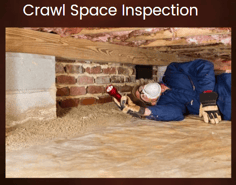Should You Be Concerned About Your Wet Crawl Space?

A wet crawl space can introduce various allergens, mold types, and contaminants into the indoor air, negatively affecting air quality. Here are some of the common culprits:
1. Mold Spores: Excess moisture in the crawl space can lead to mold growth. Mold releases tiny spores into the air, which can become airborne and find their way into your living spaces. Common mold types include Aspergillus, Penicillium, and Stachybotrys (commonly known as black mold). Inhaling mold spores can trigger allergies, respiratory issues, and other health problems.
2. Dust Mites: Dust mites thrive in humid environments, such as wet crawl spaces. These microscopic creatures feed on dust and shed skin flakes. Their waste particles and body fragments become airborne and can be a potent allergen for individuals with dust mite allergies.
3. Bacteria and Viruses: Excess moisture can create conditions suitable for the growth of bacteria and viruses. Although most crawl spaces don't contain harmful pathogens, the potential for these microorganisms to become airborne exists, especially if there is a compromised vapor barrier or liner.
4. Allergenic Particles: Wet crawl spaces can harbor a variety of allergenic particles, including pollen, pet dander, and insect remains. These particles can be drawn into the crawl space through vents or gaps, become suspended in the air, and affect indoor air quality.
5. Volatile Organic Compounds (VOCs): Moist conditions in crawl spaces can promote the release of volatile organic compounds from building materials, paints, adhesives, and other sources. Elevated VOC levels can contribute to poor air quality and cause symptoms like headaches and eye irritation.
6. Pest Allergens: Damp crawl spaces attract pests like termites, ants, and rodents. These pests can introduce allergenic proteins and fecal matter into the crawl space environment, which can then become airborne and impact indoor air quality.
7. Radon Gas: In some regions, radon gas, a naturally occurring radioactive gas, can infiltrate crawl spaces through the soil. Radon is odorless and colorless, making it difficult to detect without proper testing. Prolonged exposure to elevated radon levels can increase the risk of lung cancer.
8. Odors: Wet crawl spaces can develop musty, unpleasant odors due to mold and bacterial growth. These odors can permeate into the living spaces above and negatively affect indoor air quality.
It's important to address moisture issues in crawl spaces promptly to prevent the proliferation of these contaminants and allergens. Proper moisture control measures, such as crawl space lining, encapsulation, and dehumidification, can help improve air quality and create a healthier living environment. Regular inspections and maintenance of the crawl space are also essential to ensure long-term air quality benefits.


